Ultrasonic Metal Welding: Empowering Advances in Battery Tech (.PDF Download)
As demands intensify for superior battery performance, innovative battery technologies continue to advance in remarkable ways to minimize space, maximize power density and storage capacity, as well as extend operating time and capacity. One technology that’s helped usher in such advances over the last 25 years is ultrasonic welding.
Ultrasonic metal welding, which came into broad use around 1990, lends itself extremely well to joining the often thin, fragile, and dissimilar nonferrous materials that are essential to advanced battery designs. These soft, conductive materials include copper, aluminum, nickel, brass, titanium, silver, and even gold. Today, ultrasonically welded connections perform in batteries that power cellphones, laptops, implantable medical devices, electric and hybrid vehicles, military drones, remote-control aircraft and vehicles, and even NASA’s Mars rovers, Spirit and Opportunity.
